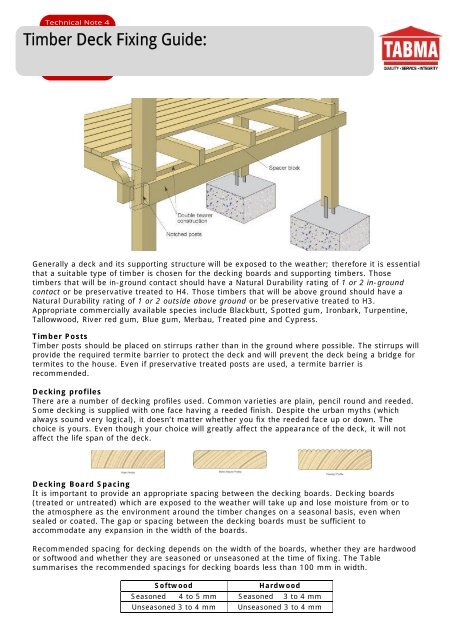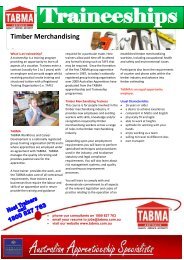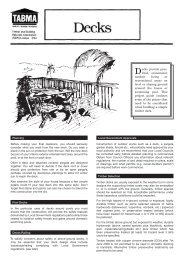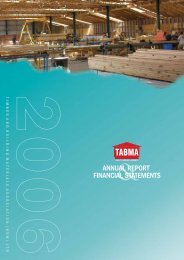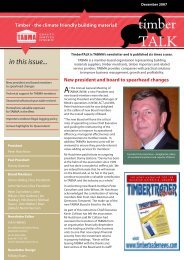Create successful ePaper yourself
Turn your PDF publications into a flip-book with our unique Google optimized e-Paper software.
Technical Note 4<br />
<strong>Timber</strong> <strong>Deck</strong> <strong>Fixing</strong> <strong>Guide</strong>:<br />
Generally a deck and its supporting structure will be exposed to the weather; therefore it is essential<br />
that a suitable type of timber is chosen for the decking boards and supporting timbers. Those<br />
timbers that will be in-ground contact should have a Natural Durability rating of 1 or 2 in-ground<br />
contact or be preservative treated to H4. Those timbers that will be above ground should have a<br />
Natural Durability rating of 1 or 2 outside above ground or be preservative treated to H3.<br />
Appropriate commercially available species include Blackbutt, Spotted gum, Ironbark, Turpentine,<br />
Tallowwood, River red gum, Blue gum, Merbau, Treated pine and Cypress.<br />
<strong>Timber</strong> Posts<br />
<strong>Timber</strong> posts should be placed on stirrups rather than in the ground where possible. The stirrups will<br />
provide the required termite barrier to protect the deck and will prevent the deck being a bridge for<br />
termites to the house. Even if preservative treated posts are used, a termite barrier is<br />
recommended.<br />
<strong>Deck</strong>ing profiles<br />
There are a number of decking profiles used. Common varieties are plain, pencil round and reeded.<br />
Some decking is supplied with one face having a reeded finish. Despite the urban myths (which<br />
always sound very logical), it doesn’t matter whether you fix the reeded face up or down. The<br />
choice is yours. Even though your choice will greatly affect the appearance of the deck, it will not<br />
affect the life span of the deck.<br />
<strong>Deck</strong>ing Board Spacing<br />
It is important to provide an appropriate spacing between the decking boards. <strong>Deck</strong>ing boards<br />
(treated or untreated) which are exposed to the weather will take up and lose moisture from or to<br />
the atmosphere as the environment around the timber changes on a seasonal basis, even when<br />
sealed or coated. The gap or spacing between the decking boards must be sufficient to<br />
accommodate any expansion in the width of the boards.<br />
Recommended spacing for decking depends on the width of the boards, whether they are hardwood<br />
or softwood and whether they are seasoned or unseasoned at the time of fixing. The Table<br />
summarises the recommended spacings for decking boards less than 100 mm in width.<br />
Softwood<br />
Hardwood<br />
Seasoned 4 to 5 mm Seasoned 3 to 4 mm<br />
Unseasoned 3 to 4 mm<br />
Unseasoned 3 to 4 mm
<strong>Fixing</strong>s the decking boards to <strong>Timber</strong> Joists<br />
For a weather exposed deck, all fixings such as bolts and nails should be hot dipped galvanised,<br />
stainless steel or similar.<br />
Generally speaking, the two nails in a board at any joist should not form a single line with the nails<br />
in the other boards on that joist. It is best to stagger the nails so that there are two lines of nails<br />
along the joist. This lessens the chance of a single line of nails creating (over time) a split in the top<br />
surface of the joist. Each of the two nails in a board should be driven at an opposing angle to<br />
increase the holding capacity of the nails.<br />
Some decking nails are designed to be fixed so that the nail head remains proud of the surface of<br />
the board but in an attractive way. Other nails are designed to be fixed so that the nail head is<br />
driven below the surface of the board. This creates a void in the surface of the board which should<br />
be filled with an appropriate filler. The filer reduces the moisture collecting in the void and the<br />
subsequent staining of the timber that may occur.<br />
To reduce the possibility of splitting, nails should not be too near the edge of the board. Pre drill the<br />
board when nailing the ends of the boards to the joists.<br />
In most decks there will be some butt joints.<br />
Care should be taken to ensure these butt<br />
joints are randomly spaced to avoid butt<br />
joints in adjacent boards being next to each<br />
other.<br />
There are two methods of protecting the top<br />
surface of the joists. A brush on timber<br />
preservative can be applied to the top surface<br />
of the joists prior to fixing the decking boards<br />
to the joists. Alternatively, an appropriate<br />
protective strip can be fixed to the top<br />
surface of the joists. Specially made protective<br />
strips are available.<br />
AS 1684 Residential <strong>Timber</strong> Frame Construction Standard provides the minimum requirements for<br />
the spacing, size and grade of bearers and joists and the minimum requirements for the thickness,<br />
span, grade and fastenings for decking boards.<br />
<strong>Deck</strong>ing Joists Nailing<br />
Hot-dip galvanised or stainless steel, 2 nails per board<br />
crossing<br />
Machine Driven<br />
Hand-Driven<br />
Hardwood<br />
and<br />
Cypress<br />
Treated<br />
softwood<br />
Hardwood and<br />
Cypress<br />
Treated softwood<br />
Hardwood and<br />
Cypress<br />
Treated softwood<br />
50 x 2.5 flat or dome-head 50 x 20.8 bullet head<br />
50 x 2.5 flathead<br />
deformed<br />
shank<br />
65 x 2.5 flator<br />
domed head<br />
50 x 20.8<br />
bullet head<br />
deformed<br />
shank<br />
65 x 2.8 bullethead<br />
50 x 2.5 flat or dome-head 50 x 2.5 flat or dome-head<br />
50 x 2.5 flathead<br />
deformed<br />
shank<br />
65 x 2.5 flathead<br />
50 x 2.8 flathead<br />
deformed<br />
shank<br />
65 x 2.8 flathead
<strong>Deck</strong>ing Grade Minimum<br />
Thickness (mm)<br />
Maximum Joist<br />
Spacing (mm)<br />
Hardwood<br />
Standard Grade<br />
19 500<br />
AS 2796.1<br />
Cypress Grade 1<br />
AS 1810<br />
19<br />
21<br />
400<br />
450<br />
Treated softwood Standard grade<br />
AS 4785.1<br />
19<br />
22<br />
400<br />
450<br />
<strong>Fixing</strong>s the decking boards to Steel Joists<br />
This practice is not always successful because the screws normally provided are not suitable for<br />
fixing timber to steel. During periods of higher humidity, the expanding timber may cause the<br />
screws to fail in shear. It is recommended that the decking boards be nailed or screwed to a timber<br />
batten affixed above or beside the steel joist.<br />
Finishing the <strong>Deck</strong>ing<br />
The industry recommends as a minimum, that a protective coating should be applied to all surfaces<br />
(including any freshly cut end) of each decking board, preferably before fixing to the joists. A<br />
protective coating includes products which penetrate the surface of the timber and products which<br />
provide a film or coating to the surface of the timber. This protective coating of the timber surface<br />
will minimise the effects of weathering of any timber (treated or untreated) in an exposed situation.<br />
The purpose of the protective coating is to slow down the rate at which the timber will take up or<br />
lose moisture. By slowing that rate down, the severity of any checking is considerably reduced. The<br />
coating should contain a fungicide to prevent mould growing on any sugars or starches that may be<br />
in the coating.<br />
Tannin Bleed<br />
Most timbers contain water-soluble extractives which provide colour and some decay resistance to<br />
the timber. Discolouration from these water-soluble extractives will be leached to the surface of the<br />
timber whenever moisture leaves the timber. Because the discolouration is water-soluble, it can be<br />
washed to other surfaces and leave an unsightly stain which can be difficult to remove from<br />
brickwork and concrete. To lesson the likelihood of such staining, use seasoned timber and apply a<br />
protective coating to all surfaces (including any freshly cut ends).<br />
Avoid using any tools which may deposit fine iron filings on the timber surface. Any iron filings which<br />
are not cleaned from the surface are likely to create unsightly black staining of the timber. An angle<br />
grinder cutting bricks creates iron filings from the metal mesh which forms the base of the cutting<br />
disk.<br />
Resin Bleed<br />
Some softwood species such as radiata pine and slash pine can be prone to resin bleed. Only some<br />
boards are affected. If a board shows obvious signs of resin bleed then don’t fix it in the deck. If it<br />
has to be fixed in the deck, fix it in a position where the resin bleed won’t be a problem. Sometimes<br />
it may not be obvious that a board is prone to resin bleed until after the finished deck has been<br />
exposed to a period of hot weather. In such circumstances the resin can be cleaned up or the<br />
offending board replaced.<br />
Bushfire Resisting <strong>Timber</strong><br />
AS 3959 – 1999 Construction in Bushfire Prone Areas, permits fire-retardant-treated-timber to be<br />
used in certain bushfire prone areas where the use of timber externally is otherwise not permitted.<br />
Included in the definition of fire-retardant-treated-timber are timber species which meet specified<br />
parameters without having to be subjected to a fire retardant treatment. A number of species have<br />
been tested.<br />
Seven Hardwood species have been shown to meet the parameters. They are —Blackbutt, Spotted<br />
gum, Red ironbark, Turpentine, River red gum, Silvertop ash and Merbau.<br />
Andrew,<br />
This publication was produced by the <strong>Timber</strong> and Building Materials Association, in conjunction with the <strong>Timber</strong> Development Association (NSW).<br />
Important notice: The information and advice provided in the publication is intended as a guide only. As successful design and construction depends<br />
upon numerous factors outside the scope of this publication, the <strong>Timber</strong> Development Association (NSW) accepts no responsibility for specifications in,<br />
nor work done or omitted to be done in reliance on this information sheet. Whilst all care has been taken to ensure the accuracy of the information<br />
contained in this publication, the <strong>Timber</strong> Development Association (NSW) disclaims, to the full extent permitted by law, all and any liability for any<br />
damage or loss, whether direct, indirect, special or consequential, arising directly or indirectly out of use of or reliance on this guide, whether as a result<br />
of the <strong>Timber</strong> Development Association (NSW) negligence or otherwise.<br />
Version 1 - Dec 2008


